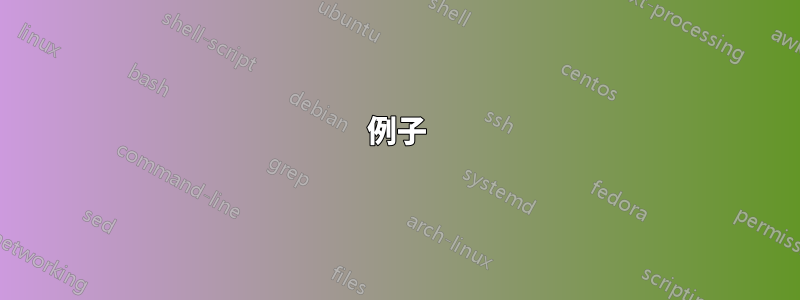
如果我定義一個函數如\SetKwFunction{Func}{func}Algorithm2e 那樣,\Func{a, b}則列印
函數(a,b)
預設情況下。我怎麼才能讓它列印
函數[a,b]
就像 Wolfram 或
函數 ab
就像哈斯克爾一樣?
我查看了algorithm2e的文檔,但沒有找到任何相關內容,但無法更改這一點似乎是algorithm2e中可用的所有自訂的一個奇怪的限制。如果不可能,有哪些簡單的替代方案可以取代\SetKwFunction類似的行為和能力?
例子
該文件的序言是這樣的:
\documentclass{article}
\usepackage[vlined]{algorithm2e}
\SetFuncSty{textsf}
\SetKwProg{Fn}{function}{}{}
第一個案例由以下程式碼生成,其他案例顯示了它應該是什麼樣子,但是透過解決方法生成的。
\begin{algorithm}[H]
\SetKwFunction{Factorial}{factorial}
\Fn{\Factorial{x}}{
\uIf{\(x \le 1\)}{
0
}\Else{
\(x \cdot \Factorial{\(x-1\)}\)
} }
\end{algorithm}
This here \Factorial{x} grows very rapidly with \(x\).
最後一種factorial x - 1情況應該有括號,但我注意到這個錯誤為時已晚,並決定保留它以供演示。
答案1
我建議對包裹進行一些手術。左括號和右括號是硬連線的,因此我們用巨集替換它們。也為分隔符號指定了單獨的樣式。
\documentclass{article}
\usepackage[vlined]{algorithm2e}
\makeatletter
\renewcommand{\SetKwFunction}[2]{%
\expandafter\gdef\csname @#1\endcsname##1{%
\FuncSty{#2}\FuncDelSty{\FuncOpen}\FuncArgSty{##1}\FuncDelSty{\FuncClose}%
}%
\expandafter\gdef\csname#1\endcsname{%
\@ifnextchar\bgroup{\csname @#1\endcsname}{\FuncSty{#2}\xspace}%
}%
}
\newcommand{\FuncDelSty}[1]{\textnormal{#1}\unskip}
\newcommand{\SetFuncDelSty}[1]{%
\renewcommand{\FuncDelSty}[1]{\textnormal{\csname#1\endcsname{##1}}\unskip}%
}
\providecommand{\gobblearg}[1]{}
\newcommand{\FuncOpen}{(}
\newcommand{\FuncClose}{)}
\newcommand{\matharg}[1]{\ensuremath{#1}}
\SetFuncArgSty{matharg} % function arguments are in math, not in text
\makeatother
\SetFuncSty{textsf}
\SetKwProg{Fn}{function}{}{}
\ExplSyntaxOn
\NewDocumentCommand{\haskellargs}{m}
{
\seq_set_from_clist:Nn \l_tmpa_seq { #1 }
\ensuremath{\;\seq_use:Nn \l_tmpa_seq { \; }}
}
\ExplSyntaxOff
\begin{document}
\section*{Standard}
\begin{algorithm}[H]
\SetKwFunction{Factorial}{factorial}
\Fn{\Factorial{x}}{
\uIf{\(x \le 1\)}{
0
}\Else{
\(x \cdot \Factorial{x-1}\)
} }
\end{algorithm}
\section*{Brackets}
\begin{algorithm}[H]
\SetKwFunction{Factorial}{factorial}
\renewcommand{\FuncOpen}{[}\renewcommand{\FuncClose}{]}
\Fn{\Factorial{x}}{
\uIf{\(x \le 1\)}{
0
}\Else{
\(x \cdot \Factorial{x-1}\)
} }
\end{algorithm}
\section*{Haskell}
\begin{algorithm}[H]
\SetKwFunction{Factorial}{factorial}
\SetFuncArgSty{haskellargs}
\renewcommand{\FuncOpen}{}\renewcommand{\FuncClose}{}
\Fn{\Factorial{x}}{
\uIf{\(x \le 1\)}{
0
}\Else{
\(x \cdot \Factorial{(x-1)}\)
} }
\end{algorithm}
\begin{algorithm}[H]
\SetKwFunction{Test}{test}
\SetFuncArgSty{haskellargs}
\renewcommand{\FuncOpen}{}\renewcommand{\FuncClose}{}
\Fn{\Test{x,y}}{
\uIf{\(x>y\)}{
$x-y$
}\Else{
$y-x$
} }
\end{algorithm}
\end{document}
當然,您將一勞永逸地選擇樣式。
答案2
這可以透過更改SetKwFunction實現來實現,如下所示:
\documentclass{article}
\usepackage{algorithm2e}
\makeatletter
\renewcommand{\SetKwFunction}[2]{%
\expandafter\gdef\csname @#1\endcsname##1{\FuncSty{#2[}\FuncArgSty{##1}\FuncSty{]}}%
\expandafter\gdef\csname#1\endcsname{%
\@ifnextchar\bgroup{\csname @#1\endcsname}{\FuncSty{#2}\xspace}}%
}%
\makeatother
\begin{document}
\begin{algorithm}
\SetKwFunction{Func}{func}
\SetKwProg{Fn}{Function}{:}{\KwRet}
\Fn{\Func{$f$, $a$, $b$, $\varepsilon$}}{
a\;
b\;
}
\end{algorithm}
\end{document}





